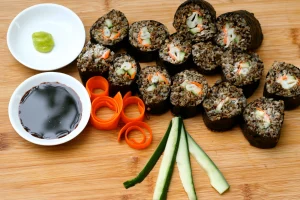
Sushi, a beloved staple of Japanese cuisine, has won hearts worldwide with its delicate flavors, stunning presentation, and nutritional benefits. Traditionally crafted with vinegared wild rice sushi , sushi’s popularity is now paving the way for creative adaptations. One such innovation is the use of wild rice as a substitute for white rice, offering a healthier and more sustainable alternative without compromising the essence of the dish.
What is Wild Rice?
Wild rice, despite its name, is not true rice but a seed of aquatic grasses native to North America. With its nutty flavor, chewy texture, and dark, glossy appearance, wild rice stands apart from the soft and slightly sweet white rice traditionally used in sushi. Beyond its unique taste and texture, wild rice boasts an impressive nutritional profile that has attracted the attention of health-conscious diners.
Nutritional Advantages of Wild Rice
Compared to white rice, wild rice is a nutrient powerhouse. It is high in protein, fiber, and essential minerals such as magnesium, phosphorus, and zinc. These nutrients contribute to muscle development, bone health, and improved immune function. Additionally, wild rice is naturally gluten-free and has a lower glycemic index than white rice, making it an excellent option for people managing diabetes or seeking to maintain steady energy levels.
One of the standout benefits of wild rice is its antioxidant content. Rich in compounds like ferulic acid and phytic acid, wild rice helps combat oxidative stress and reduce inflammation. By incorporating wild rice into sushi, diners can enjoy a meal that not only satisfies their taste buds but also supports their overall well-being.
Why Wild Rice is a Great Alternative for Sushi
Replacing white rice with wild rice in sushi offers several benefits:
- Enhanced Flavor and Texture: Wild rice’s nutty taste and firm texture add depth and complexity to sushi, creating a unique sensory experience. This contrast complements traditional fillings like fresh fish, avocado, and cucumber, as well as modern variations featuring roasted vegetables or tofu.
- Improved Health Profile: Wild rice’s high fiber content aids digestion, while its protein supports satiety, making wild rice sushi a more filling and nutritionally balanced option. This is particularly appealing to those looking to enjoy sushi as part of a healthier diet.
- Visual Appeal: The dark, earthy tones of wild rice provide a striking visual contrast to the vibrant colors of sushi ingredients. This aesthetic enhancement makes wild rice sushi a feast for both the eyes and the palate.
- Catering to Dietary Needs: With its naturally gluten-free properties and higher nutrient density, wild rice is an ideal choice for individuals with dietary restrictions or specific nutritional goals.
Sustainability and Wild Rice
As sustainability becomes an increasingly important focus in the culinary world, wild rice offers a compelling advantage. Cultivated in natural waterways with minimal environmental impact, wild rice production is often more eco-friendly than the intensive farming methods used for white rice. Furthermore, supporting wild rice promotes the preservation of traditional practices by Indigenous communities in North America, who have been harvesting and using wild rice for centuries.
Wild rice sushi aligns with the growing demand for sustainable dining options, allowing chefs to create dishes that are both delicious and environmentally conscious. By pairing wild rice with locally sourced ingredients, the ecological footprint of sushi can be significantly reduced, appealing to diners who prioritize sustainability.
The Versatility of Wild Rice Sushi
Wild rice sushi opens the door to endless possibilities in flavor and presentation. Its robust taste pairs well with both traditional and unconventional ingredients, enabling chefs to experiment with bold combinations. For example, smoked salmon, cream cheese, and wild rice create a fusion roll with rich and satisfying flavors. Alternatively, vegetarian options like roasted sweet potato, asparagus, and miso-marinated eggplant shine when paired with wild rice.
In terms of presentation, wild rice’s darker hue provides a dramatic backdrop for colorful fillings, enhancing the visual appeal of sushi platters. This makes wild rice sushi an ideal choice for special occasions, where aesthetics play a key role in the dining experience.
Embracing Innovation While Honoring Tradition
Japanese cuisine is deeply rooted in tradition, but it has always embraced innovation to adapt to changing times. Wild rice sushi is a testament to this adaptability, offering a modern twist that respects the core principles of sushi-making. While some purists may view it as a departure from tradition, wild rice sushi represents an evolution that aligns with contemporary tastes and values.
Chefs incorporating wild rice into their sushi menus are not only expanding their culinary repertoire but also appealing to a broader audience. From health-conscious diners to sustainability advocates, wild rice sushi caters to a diverse range of preferences while maintaining the artistry and elegance that sushi is known for.
The Future of Sushi with Wild Rice
As global palates evolve, so too does the definition of what sushi can be. Wild rice sushi exemplifies this evolution, blending tradition with innovation to create a dish that resonates with modern diners. Its health benefits, sustainability credentials, and unique flavor profile position it as a standout option in the world of sushi.
Whether you’re a seasoned sushi lover or new to this culinary art form, wild rice sushi offers a fresh and exciting way to enjoy a classic dish. By embracing wild rice, chefs and diners alike are contributing to a healthier, more sustainable future for Japanese cuisine. This modern take on sushi proves that sometimes, the best way to honor tradition is to innovate within it.





